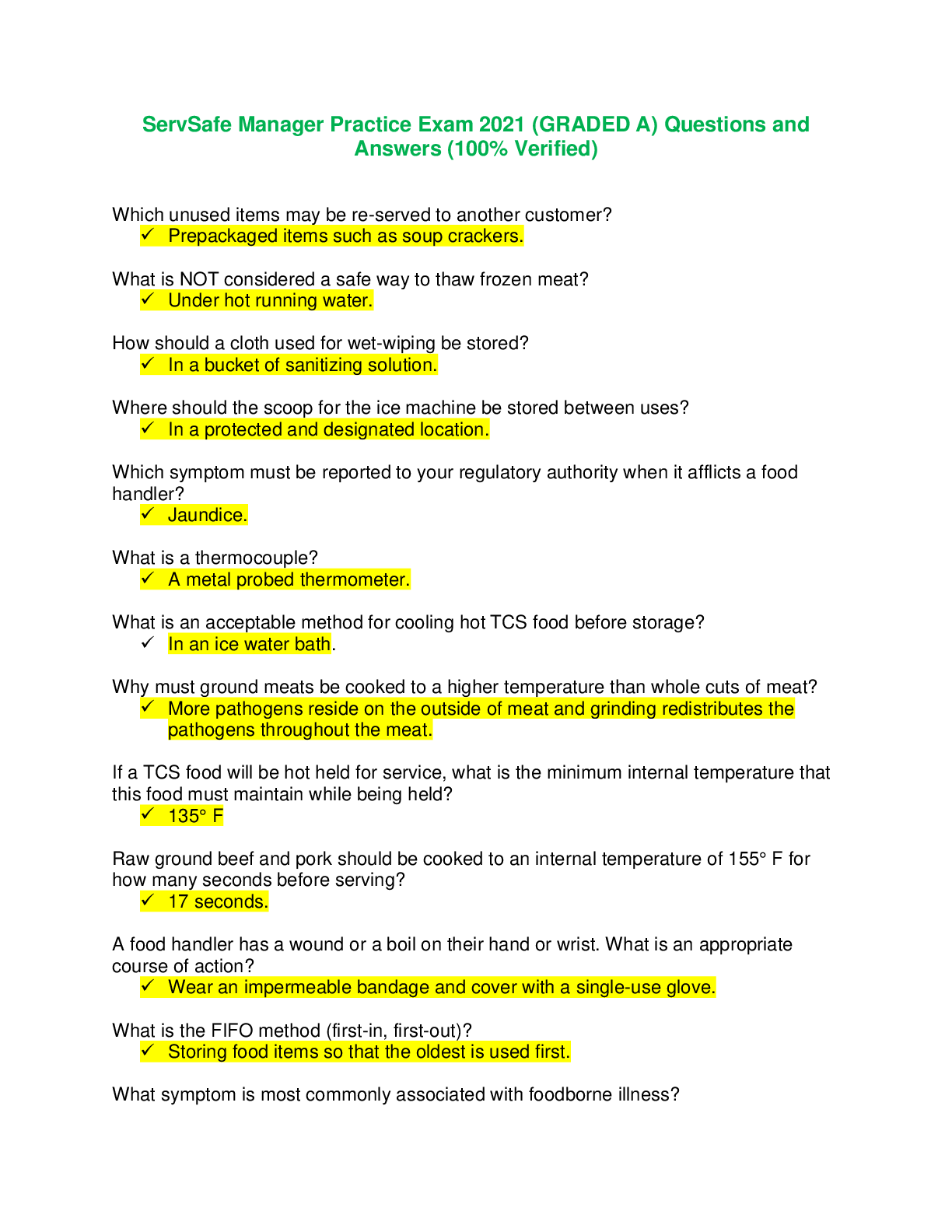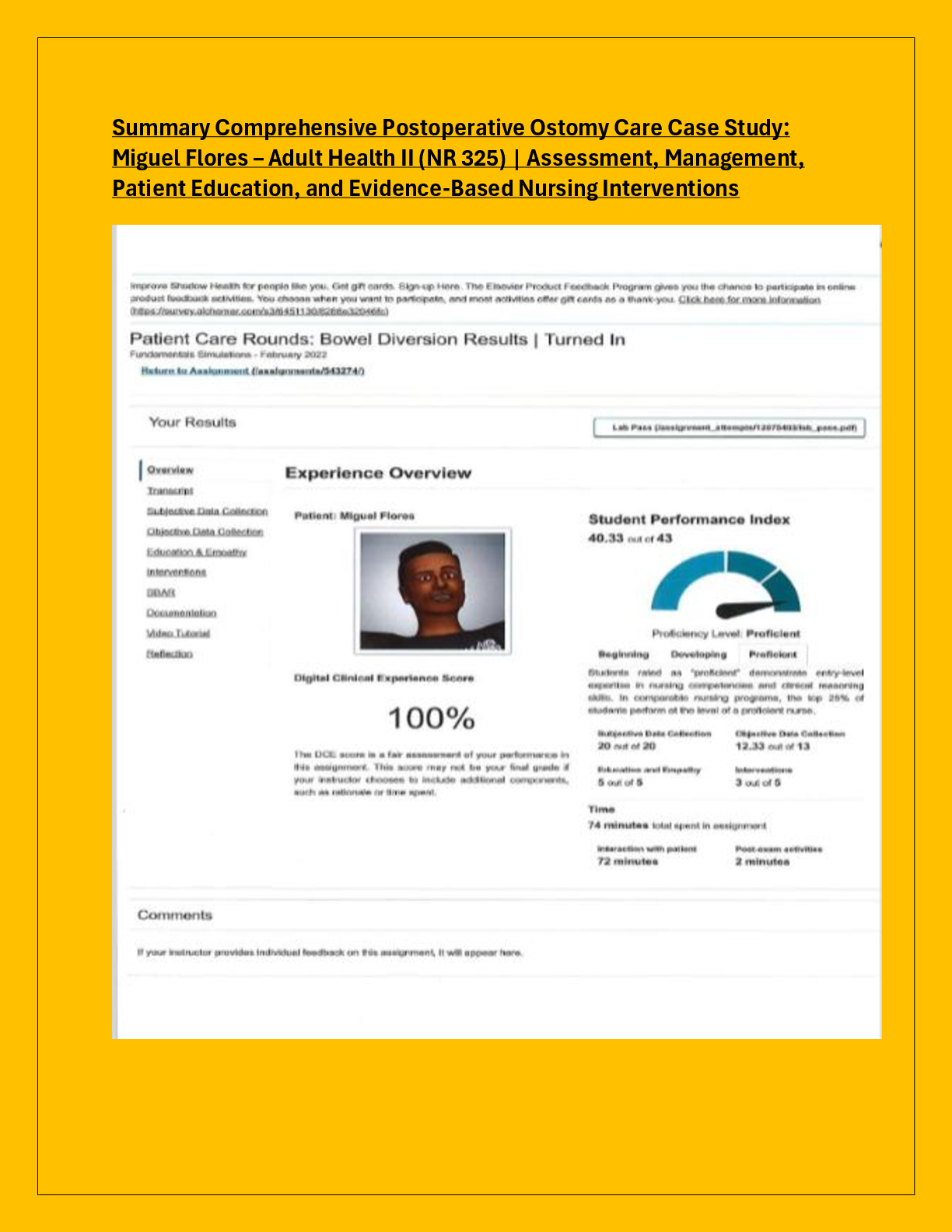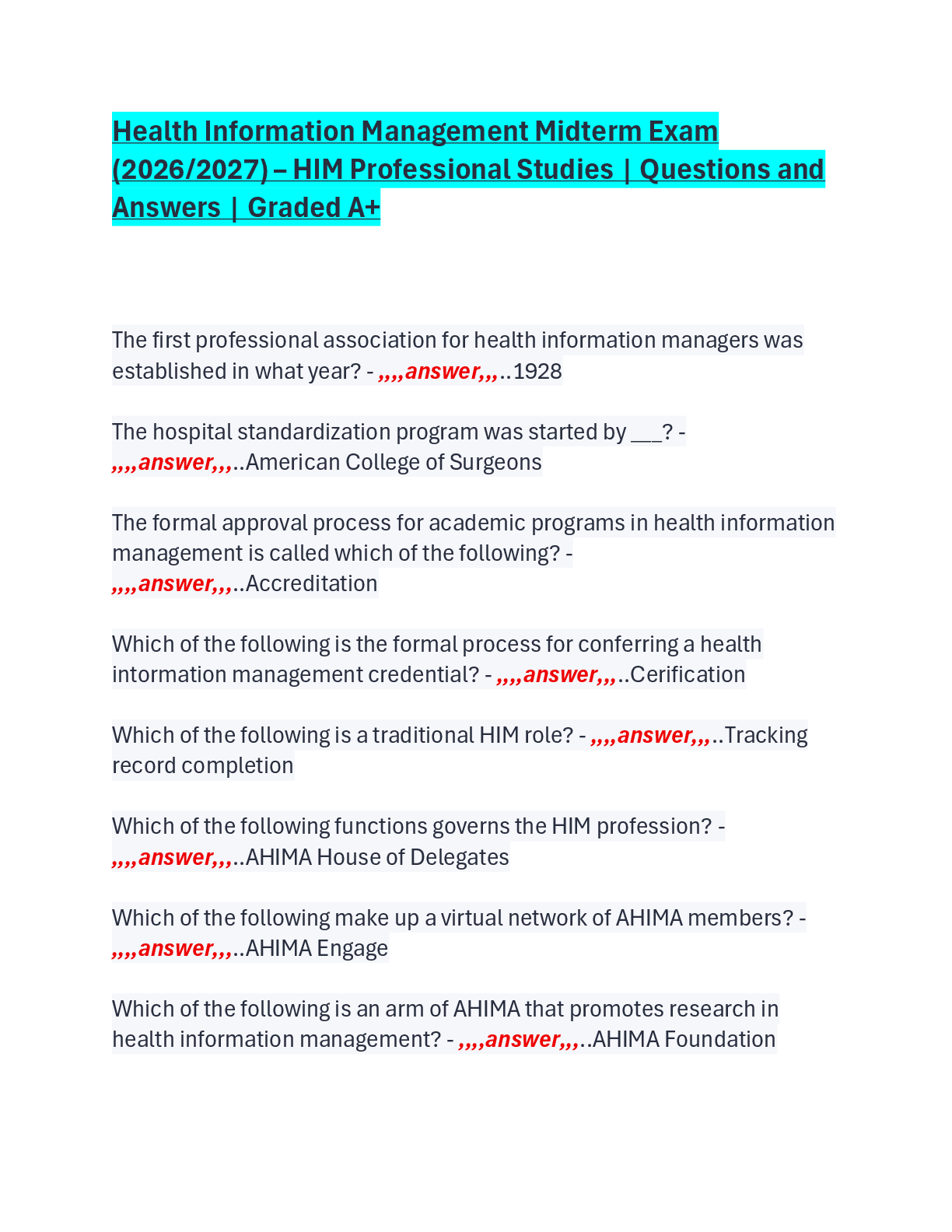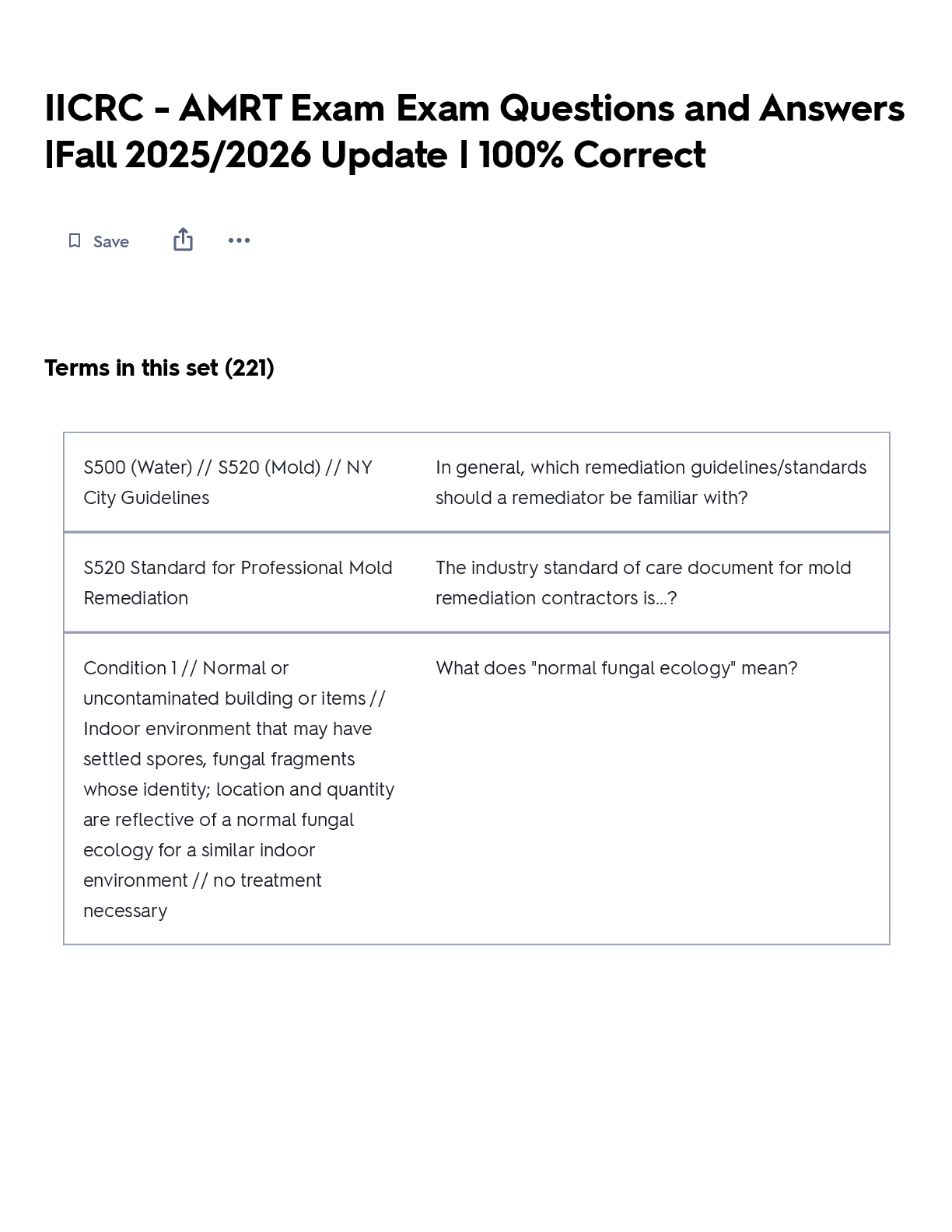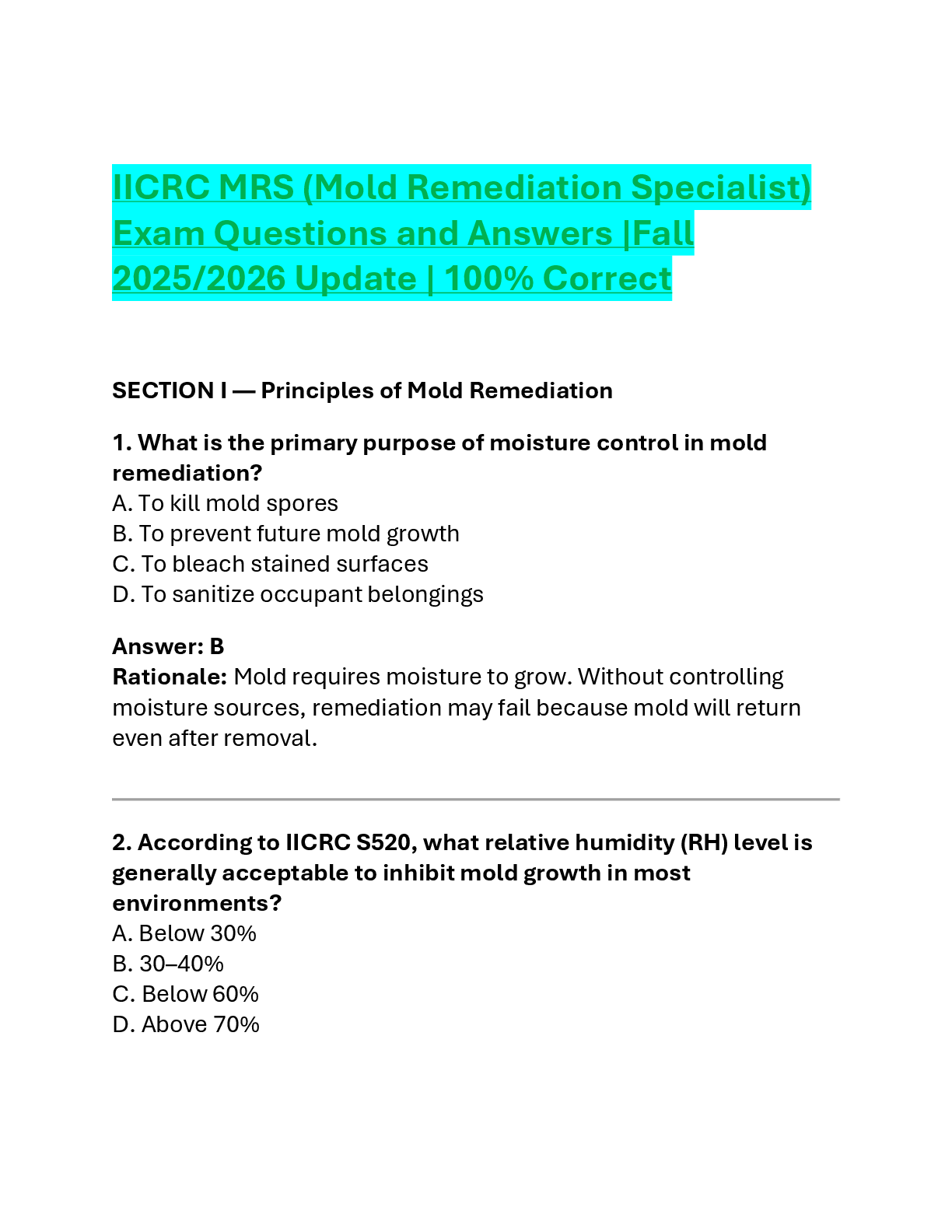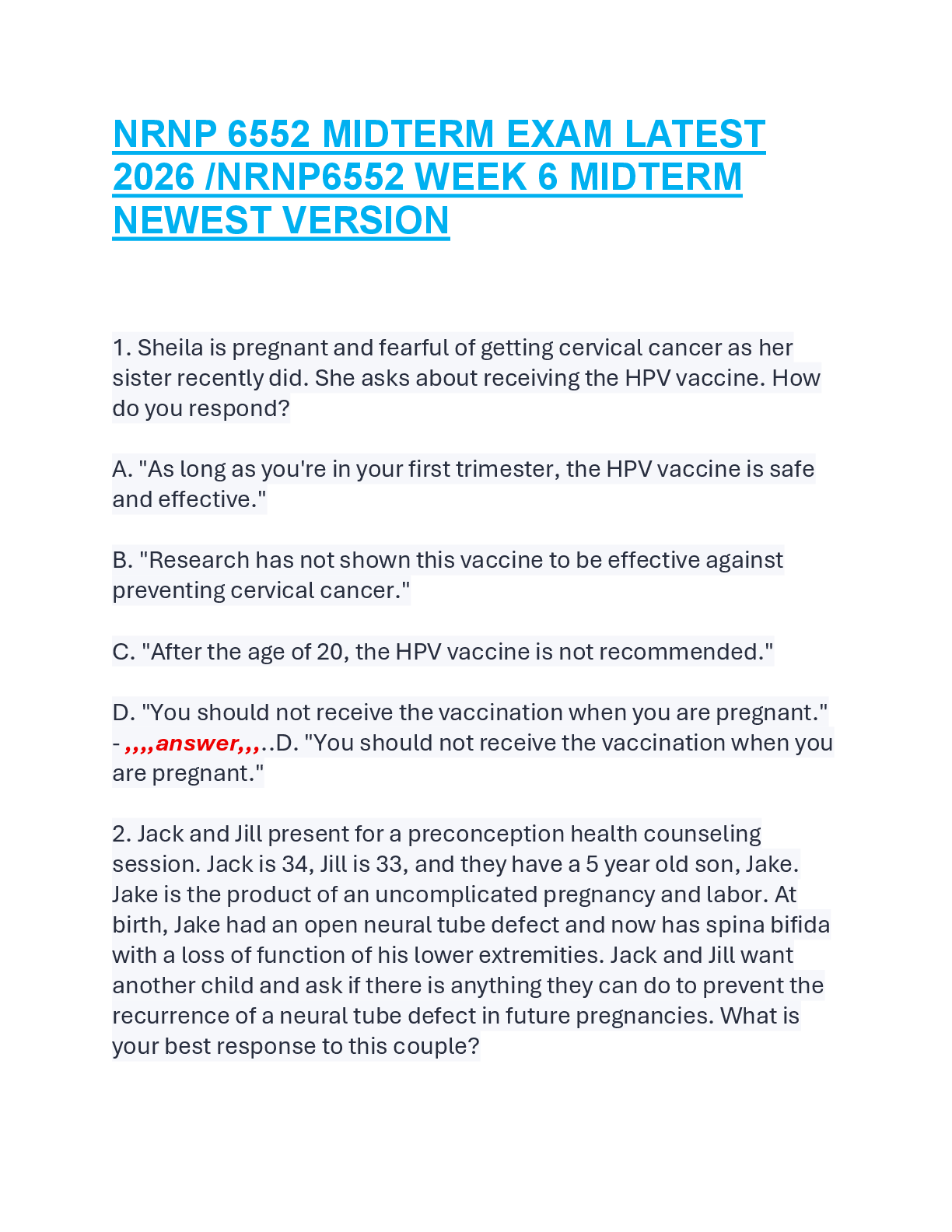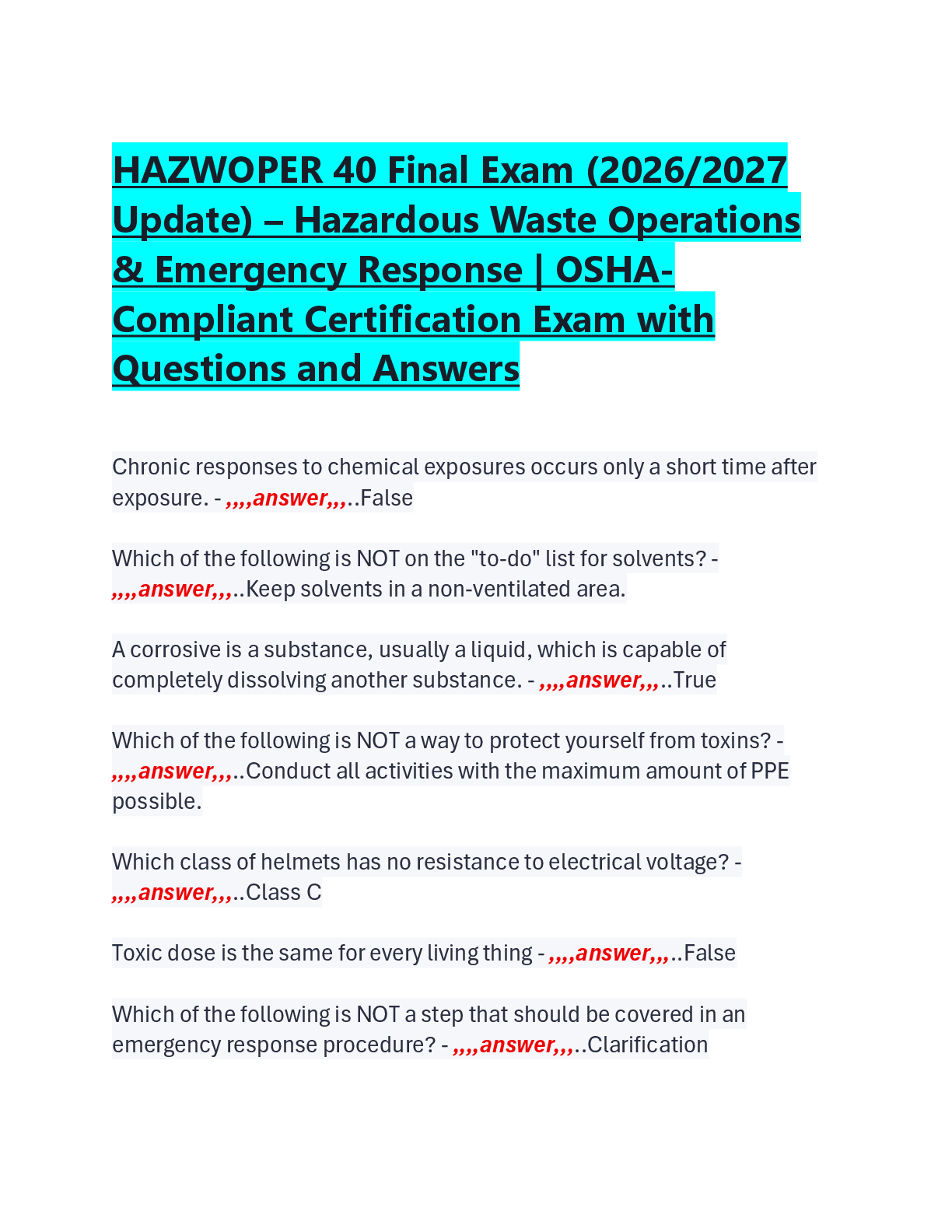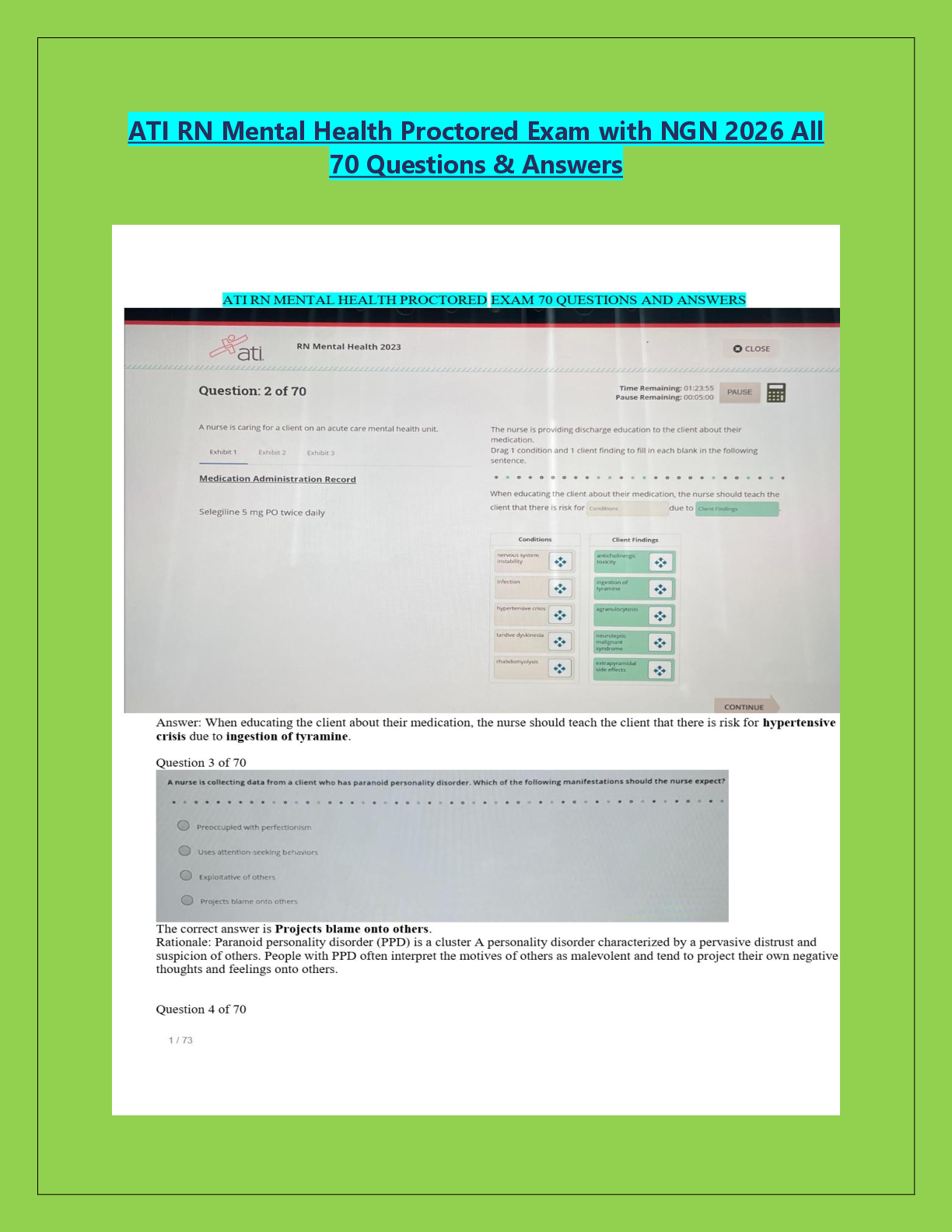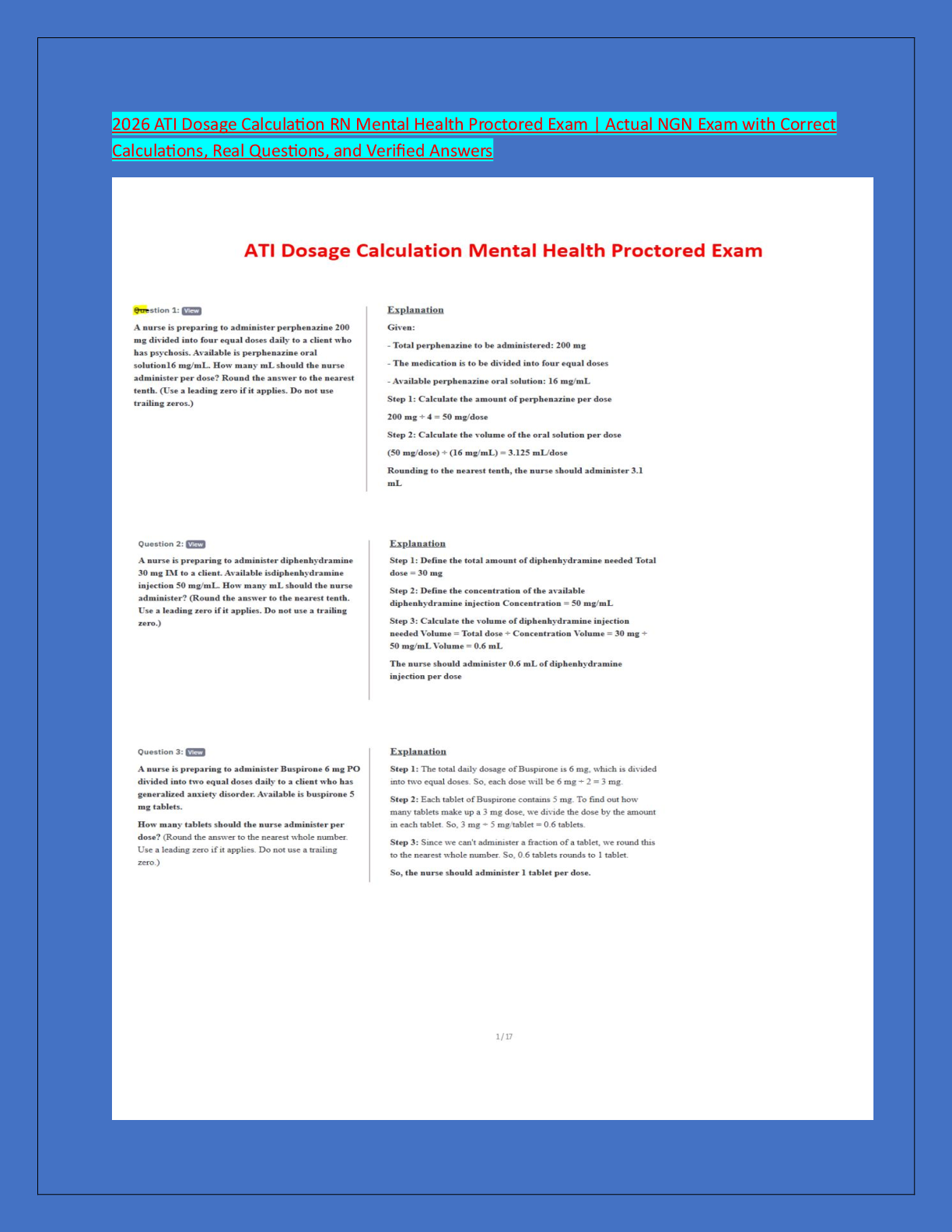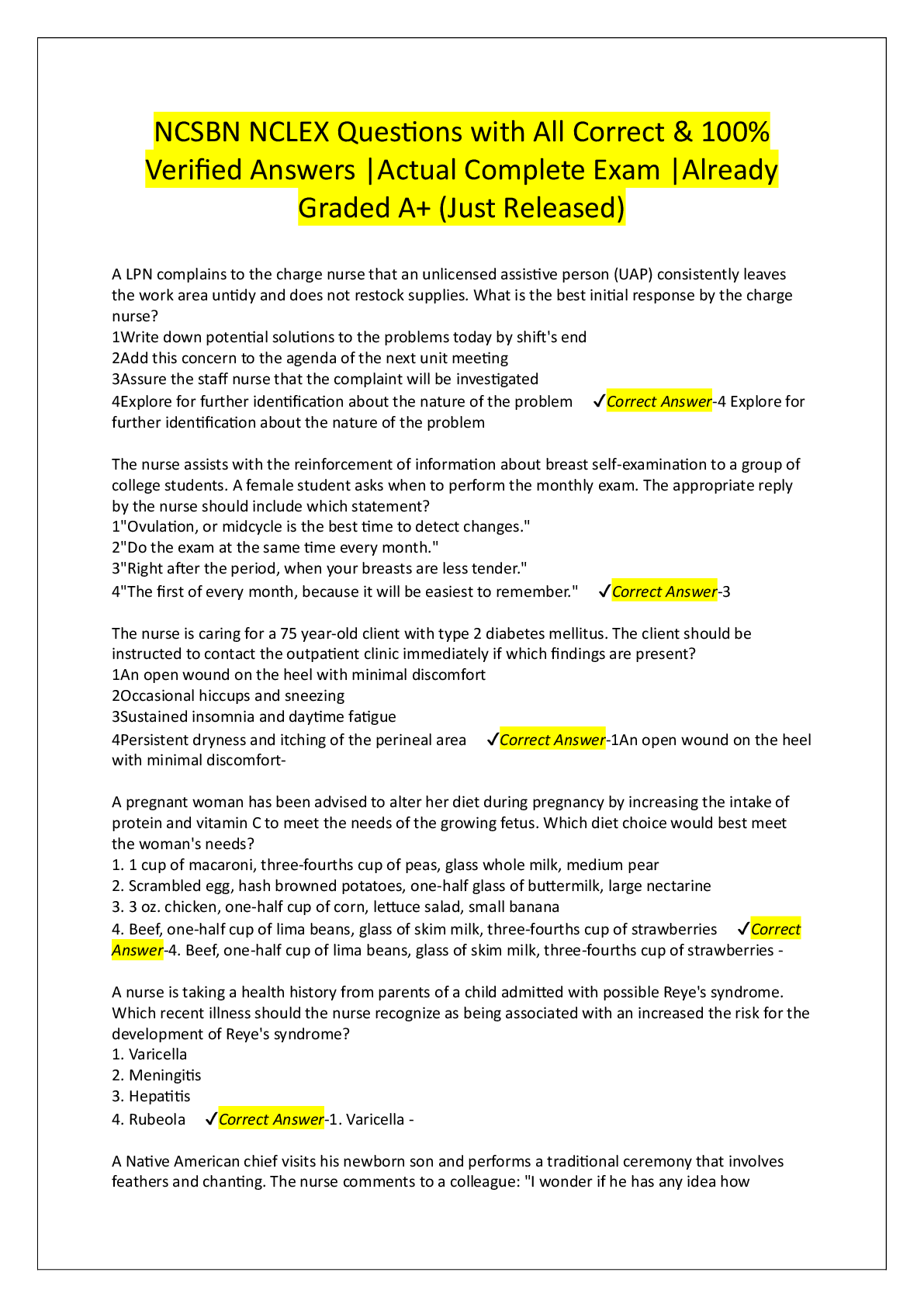*NURSING > EXAMs > NURSING 2362 Module 5 Exam (A Graded) Latest Questions and Complete Solutions (All)
NURSING 2362 Module 5 Exam (A Graded) Latest Questions and Complete Solutions
Document Content and Description Below
NURSING 2362 Module 5 Exam Questions 1. ID: 8482553041A client with leukemia is being considered for a bone marrow transplant. The healthcare team is discussing the risks and benefits of this trea ... tment and other possible treatments with the goal of inflicting the least possible harm on the client. Which principle of healthcare ethics is the team practicing? Justice Fidelity Autonomy Nonmaleficence Correct Rationale: Nonmaleficence is the avoidance of hurt or harm. Remember that in healthcare ethics, ethical practice involves not only the will to do good but also the equal commitment to do no harm. Healthcare professionals try to balance the risks and benefits of a plan of care while striving to do the least possible harm. Justice refers to fairness and equity and ensuring fair allocation of resources, such as nursing care for all clients. Fidelity is the keeping of promises made to clients, families, and other healthcare professionals. Autonomy refers to a person’s independence and represents an agreement to respect another’s right to determine his or her course of action. Test-Taking Strategy: Focus on the subject - the ethical principle being utilized. Recall the definition of each item in the options. Note the relationship of the words “least possible harm” in the question and the definition of nonmaleficence. Review: principles of healthcare ethics. Reference: Potter, P., & Perry, A. (2009). Fundamentals of nursing (7th ed., p. 314). St. Louis: Mosby. Cognitive Ability: Applying Client Needs: Safe and Effective Care Environment Integrated Process: Nursing Process/Implementation Content Area: Ethical/Legal Giddens Concepts: Celluar Regulation, Ethics HESI Concepts: Advocacy/Ethical/Legal Issues, Cellular Regulation Awarded 1.0 points out of 1.0 possible points. 2. ID: 8482553007Which action by the nurse represents the ethical principle of beneficence? The nurse upholds a client’s decision to refuse chemotherapy for lung cancer. The nurse follows a plan of care designed to relieve pain in a client with cancer. The nurse administers an immunization to a child even though it may cause discomfort. Correct The nurse provides equal amounts of care to all assigned clients on the basis of illness acuity. Rationale: Beneficence is taking action to help others. Although administration of a child’s immunization might cause discomfort, the benefits of protection from disease outweigh the temporary discomfort. Fidelity is keeping promises made to clients, families, and other healthcare professionals. Autonomy is a person’s independence. Respecting another’s autonomy means that you are agreeing to respect that person’s right to determine his or her course of action. Justice refers to fairness and equity, including fair allocation of resources, such as nursing care for all clients. Test-Taking Strategy: Focus on the subject, beneficence. Recalling that beneficence refers to taking action to help others will direct you to the correct option. Review: the principles of healthcare ethics . Reference: Potter, P., & Perry, A. (2009). Fundamentals of nursing (7th ed., p. 314). St. Louis: Mosby. Cognitive Ability: Applying Client Needs: Safe and Effective Care Environment Integrated Process: Nursing Process/Implementation Content Area: Ethical/Legal Giddens Concepts: Ethics, Immunity HESI Concepts: Advocacy/Ethical/Legal Issues, Immunity Awarded 1.0 points out of 1.0 possible points. 3. ID: 8482553071The nursing instructor asks a student to name an example of false imprisonment. Which situation reflects a violation of this client right? Performing a procedure without consent Telling the client that he or she may not leave the hospital Correct Threatening to give a client a medication against his or her will Observing the provision of care to the client without the client’s permission Rationale: Telling a client that he or she may not leave the hospital constitutes false imprisonment. Performing a procedure without consent is an example of battery. Threatening to give a client a medication against his or her will is assault. Invasion of privacy takes place with unreasonable intrusion into an individual’s private affairs. Observing the provision of care to a client without the client’s permission is an example of invasion of privacy. Test-Taking Strategy: Focus on the subject, an example of false imprisonment. Note the relationship of the subject and the words in the correct option. Review: the concept of false imprisonment. References: Cherry, B., & Jacob, S. (2008). Contemporary nursing issues: Trends & management (4th ed., pp. 175, 176). St. Louis: Mosby. Zerwekh, J., & Claborn, J. (2009). Nursing today: Transition and trends (6th ed., p. 424). Cognitive Ability: Evaluating Client Needs: Safe and Effective Care Environment Integrated Process: Teaching and Learning Content Area: Ethical/Legal Giddens Concepts: Health Care Law, Leadership HESI Concepts: Advocacy/Ethical/Legal Issues, Health Policy/Systems—Health Care Law Awarded 1.0 points out of 1.0 possible points. 4. ID: 8482550821The nurse and an unlicensed assistive personnel (UAP)enter a client’s room to provide care and find the client lying on the floor. Which action should the nurse take first? Ask the nursing assistant to complete an incident report Check the client’s level of consciousness and vital signs Correct Ask the nursing assistant to assist in getting the client back to bed Contact the unit secretary on the intercom and ask that the client’s health care provider be called Rationale: When a client sustains a fall, the nurse must first assess the client. The nurse should check the client’s level of consciousness and vital signs and look for any bruises or injuries sustained in the fall. If the nurse determines that the client has not sustained any injuries and that it is safe to move the client, the nurse should ask the UAP to assist in getting the client into bed. The nurse should then contact the health care provider and file an incident report. Test-Taking Strategy: Note the strategic word “first.” Use the steps of the nursing process to answer the question. The correct option is the only one that addresses assessment. Remember to always assess the client first if a client sustains a fall. Review: client injuries and procedures for filing incident reports . References: Ignatavicius, D., & Workman, M. (2010). Medical-surgical nursing: Patient–centered collaborative care (6th ed., p. 180). St. Louis: Saunders. Potter, P., & Perry, A. (2009). Fundamentals of nursing (7th ed., p. 403). St. Louis: Mosby. Cognitive Ability: Applying Client Needs: Safe and Effective Care Environment Integrated Process: Nursing Process/Implementation Content Area: Delegating/Prioritizing Giddens Concepts: Mobility, Safety HESI Concepts: Mobility, Safety Awarded 1.0 points out of 1.0 possible points. 5.ID: 8482550857Which action exemplifies the use of evidence-based practice in the delivery of client care? Donning sterile gloves to change an abdominal wound dressing Correct Encouraging a client to take an herbal substance to treat his insomnia Advising a client to agree to the treatment recommended by her health care provider Taking a rectal temperature from a client for whom bleeding precautions have been instituted Rationale: Evidence-based practice is an approach to client care in which the nurse integrates the client’s preferences, clinical expertise, and the best research evidence to deliver quality care. Donning sterile gloves to change an abdominal wound dressing reflects evidence-based practice, because it prevents the entrance of harmful bacteria into the wound. The remaining options do not reflect evidence-based practice. Taking an herbal substance could be harmful to some clients. It is nontherapeutic for a nurse to advise a client to agree to a treatment. Because of the risk of injury to the rectal mucosa, rectal temperature-taking is avoided in the client for whom bleeding precautions have been instituted. Test-Taking Strategy: Read each option carefully, focusing on the subject, evidence-based practice. Recall the definition of evidence-based practice and note the words “sterile gloves” in the correct option. Review: the situations that reflect evidence-based practice . Reference: Potter, P., & Perry, A. (2009). Fundamentals of nursing (7th ed., pp. 54-60). St. Louis: Mosby. Cognitive Ability: Applying Client Needs: Safe and Effective Care Environment Integrated Process: Nursing Process/Implementation Content Area: Leadership/Management Giddens Concepts: Evidence, Safety HESI Concepts: Evidence-Based Practice/Evidence, Safety Awarded 1.0 points out of 1.0 possible points. 6. ID: 8482550859The registered nurse has accepted a new position as case manager in a hospital. Which responsibilities are part of the nurse’s new role? Select all that apply. Evaluating and updating the plan of care as needed Correct Prescribing treatments specific to the client’s needs Assessing the client’s needs for home supplies and equipment Correct Coordinating consultations and referrals to facilitate discharge Correct Establishing a safe and cost-effective plan of care with the client Correct Rationale: A case manager is a nurse who assumes responsibility for coordinating the client's care from the point of admission through, and after, discharge. Specific responsibilities of the case manager include establishing a safe and cost-effective plan of care with the client, coordinating consultations and referrals, and facilitating discharge; initiating a plan of nursing care, care map, or clinical pathway as appropriate to guide care and evaluating and updating the plan of care as needed; ensuring that the plan of care is tailored to the client’s needs, taking into account the client’s diagnosis, self-care ability, and prescribed treatments; assessing the client’s need for equipment such as oxygen or wound care supplies and exploring available resources to provide the client with these supplies; providing resources that will assist the client in maintaining independence as much as possible; and providing the client with information on discharge procedures and the plan of care. The nurse does not prescribe treatments. Test-Taking Strategy: Focus on the subject, the responsibilities of the case manager. Note the word “prescribing” in the incorrect option. It is not within the role of the nurse to prescribe. Review: the responsibilities of the case manager if you have difficulty with this question. Reference: Potter, P., & Perry, A. (2009). Fundamentals of nursing (7th ed., p. 21). St. Louis: Mosby. Cognitive Ability: Applying Client Needs: Safe and Effective Care Environment Integrated Process: Nursing Process/Implementation Content Area: Leadership/Management Giddens Concepts: Care Coordination, Leadership HESI Concepts: Collaboration/Managing Care—Care Coordination, Collaboration/Managing Care–Leadership Awarded 4.0 points out of 4.0 possible points. 7. ID: 8482553059The nurse manager of a quality improvement program asks a nurse in the neurological unit to conduct a retrospective audit. Which action should the auditing nurse plan to perform in this type of audit? Checking the documentation written by a new nursing graduate on her assigned clients at the end of the shift Checking the crash cart to ensure that all needed supplies are readily available should an emergency arise Reviewing neurological assessment checklists for all clients on the unit to ensure that these assessments are being conducted as prescribed Obtaining the assigned medical record from the hospital’s medical record room to review documentation made during a client’s hospital stay Correct Rationale: Quality improvement, also known as performance improvement, is focused on processes or systems that significantly contribute to client safety and effective client care outcomes. Criteria are used to assess outcomes of care and determine the need for changes improve the quality of care. In a retrospective, or “looking back,” audit, the medical record is inspected after the client’s discharge for documentation of compliance with standards. In a concurrent, or “at the same time,” audit, the nursing staff’s compliance with predetermined standards and criteria is assessed as the nurses are providing care during the client’s stay. In this type of audit, a peer review approach in which members of the nursing staff are involved in data collection may be implemented. Obtaining the a client’s medical record from the medical record room for the purpose of reviewing documentation made during the client’s hospital stay is an example of a retrospective audit. The incorrect options are examples of concurrent audits. Test-Taking Strategy: Focus on the subject, a retrospective audit. Note the relationship of the word “retrospective” in the question and the description in the correct option. Review: the procedures for quality improvement and retrospective and concurrent audits if you have difficulty with this question. Reference: Potter, P., & Perry, A. (2009). Fundamentals of nursing (7th ed., pp. 64, 65). St. Louis: Mosby. Cognitive Ability: Applying Client Needs: Safe and Effective Care Environment Integrated Process: Nursing Process/Planning Content Area: Leadership/Management Giddens Concepts: Health Care Quality, Leadership HESI Concepts: Collaboration/Managing Care—Leadership, Quality Improvement/Health Care Quality Awarded 1.0 points out of 1.0 possible points. 8. ID: 8482550879The nurse preparing a client for a bronchoscopy notes that the client is wearing a gold necklace. What should the nurse do to safeguard the client’s necklace? Ask the client whether the necklace is gold Ask the client for permission to lock the necklace in the hospital safe Correct Ask the client to remove the necklace and place it in the top drawer of the bedside table Ask the client to sign a release to free the hospital of responsibility if the necklace is damaged or lost during the procedure Rationale: When a client has valuables, the nurse should give them to a family member or secure them for safekeeping. Most health care institutions require that a client sign a release form that frees the institution of responsibility if a valuable item (e.g., jewelry, money) is lost, but this does not safeguard the client’s necklace. Valuables may be locked in a designated location such as the hospital’s safe. Removing the necklace and putting it in a drawer does not safeguard it. Asking the client whether the necklace is gold is inappropriate and unrelated to the subject. Test-Taking Strategy: Focus on the subject, safeguarding the client’s necklace. Focusing on the subject and noting the word “lock” in the correct option will help you answer correctly. Review: the procedures for safeguarding a client’s valuables . Reference: Potter, P., & Perry, A. (2009). Fundamentals of nursing (7th ed., p. 1387). St. Louis: Mosby. Cognitive Ability: Applying Client Needs: Safe and Effective Care Environment Integrated Process: Nursing Process/Implementation Content Area: Ethical/Legal Giddens Concepts: Ethics, Health Care Policy HESI Concepts: Advocacy/Ethical/Legal Issues, Health Policy/Systems—Health Care Policy Awarded 1.0 points out of 1.0 possible points. 9. ID: 8482550827The nurse providing preoperative care to a client who is scheduled for a left mastectomy and axillary lymph node dissection notes that the client is wearing a wedding band on her left ring finger. Which action should the nurse take? Tape the wedding band in place Explain to the client why the wedding band must be removed Correct Ask the client whether she would like to remove the wedding band or wear it to surgery Ask the client to sign a release to free the hospital of responsibility if the wedding band is lost during surgery Rationale: In most situations a wedding band may be taped in place and worn during a surgical procedure. However, if the possibility exists that the client will experience swelling of the hand or fingers, the wedding band should be removed. On admission to a healthcare facility, the client is asked to sign a form that frees the agency from responsibility if a client’s valuable is lost. After mastectomy with axillary lymph node dissection, the client is at risk for lymphedema, which results in swelling of the arm and hand on the affected side. Therefore the appropriate nursing action is to ask the client to remove the wedding band and explain why. Test-Taking Strategy: Focus on the data in the question. Eliminate the options that are comparable or alike in that they indicate that the client may wear the wedding band during the surgical procedure. Next, recall the complications associated with mastectomy, which will direct you to the correct option. Review: preoperative procedures for a client’s valuables . Reference: Potter, P., & Perry, A. (2009). Fundamentals of nursing (7th ed., p. 1387). St. Louis: Mosby. Cognitive Ability: Applying Client Needs: Safe and Effective Care Environment Integrated Process: Nursing Process/Implementation Content Area: Perioperative Care Giddens Concepts: Cellular Regulation, Fluid and Electrolyte Balance HESI Concepts: Cellular Regulation, Fluids and Electrolytes Awarded 1.0 points out of 1.0 possible points. 10. ID: 8482548677The nurse preparing a client to go to the radiology department for a chest x-ray notes that the client is wearing a religious medal on a chain around the neck. The client, a Catholic, expresses a concern about removing the medal. What is the most appropriate action for the nurse to take? Asking the client to remove the medal until the x-ray has been completed Assisting the client in pinning the medal and chain to the waistband of the client’s pajama bottoms Correct Asking the client to place the medal in the top drawer of the bedside stand just before leaving for the radiology department Telling the client that the medal and chain will be kept at the nurses’ station for safekeeping while the client is undergoing the x-ray Rationale: A client undergoing a chest x-ray must remove all metal objects to help prevent artifacts on the x-ray. If the client expresses concern about removing the medal, the nurse should help the client pin the medal and chain to the hospital gown or in another area where it will not appear on the x-ray image. The nurse should also alert staff in the radiology department that this has been done. If the client is expressing concern about removing the medal, asking the client to remove it or leave it with the nurse or in the bedside stand is inappropriate. Each of these actions also increases the likelihood that the medal and chain will be lost. Test-Taking Strategy: Note that the client is expressing concern about removing the religious medal. Eliminate the options that are comparable or alike in that they indicate that the client should remove the medal. Also note that the correct option is the only option that addresses the client’s concern. Review: care of clients’ valuables Reference: Potter, P., & Perry, A. (2009). Fundamentals of nursing (7th ed., p. 1387). St. Louis: Mosby. Cognitive Ability: Applying Client Needs: Safe and Effective Care Environment Integrated Process: Nursing Process/Implementation Content Area: Safety Giddens Concepts: Culture, Safety HESI Concepts: Safety, Spiritual/Cultural Awarded 1.0 points out of 1.0 possible points. 11. ID: 8482553077A health care provider writes a medication prescription in a client’s record. While transcribing the prescription, the nurse notes that the prescribed dose is three times higher than the recommended dose. The nurse calls the health care provider, who states that this is the dose that the client takes at home and that it is acceptable for this client’s condition. What is the appropriate action for the nurse to take? Contacting the nursing supervisor Correct Continuing to transcribe the prescription Asking the nurse assigned to care for the client to administer the medication Verifying the prescribed dose with the client before administering the medication Rationale: A nurse must follow a physician’s prescription unless he or she believes that the prescription is in error or that it would harm the client. If a prescription is found to be incorrect or harmful, further clarification from the health care provider is necessary. If the health care provider confirms the prescription and the nurse still believes that it is inappropriate, the nurse should contact the nursing supervisor. The nurse should not continue transcribing the prescription or ask another nurse to implement the prescription. The nurse might ask the client about the medication and the dose taken at home but would not administer the medication. Test-Taking Strategy: Eliminate the options that are comparable or alike in that they indicate that the medication would be administered. Review: the nurse’s responsibilities in regard to a physician’s prescriptions . Reference: Potter, P., & Perry, A. (2009). Fundamentals of nursing (7th ed., p. 709). St. Louis: Mosby. Cognitive Ability: Applying Client Needs: Safe and Effective Care Environment Integrated Process: Nursing Process/Implementation Content Area: Ethical/Legal Giddens Concepts: Ethics, Safety HESI Concepts: Avocacy/Ethical/Legal Issues, Safety Awarded 1.0 points out of 1.0 possible points. 12. ID: 8482550811The nurse monitoring a client with a chest tube notes that there is no tidaling of fluid in the water seal chamber. After further assessment, the nurse suspects that the client’s lung has reexpanded and notifies the health care provider. The health care provider verifies with the use of a chest x-ray that the lung has reexpanded, then calls the nurse to asks that the chest tube be removed. Which action should the nurse take first? Call the nursing supervisor Explain the procedure to the client, then remove the chest tube Inform the health care provider that removal of a chest tube is not a nursing procedure Correct Obtain petrolatum-impregnated gauze and ask another nurse to assist in removing the chest tube Rationale: Actual removal of a chest tube is the duty of a health care provider. Therefore the nurse would first inform the health care provider that this is not a nursing procedure. If the health care provider insists that the nurse remove the tube, the nurse must contact the nursing supervisor. Some agency’s policies and procedures may permit an advanced practice nurse (a nurse with a master’s degree in a specialized area of nursing) to remove a chest tube. However, there is no information in the question to indicate that the nurse is an advanced practice nurse. Test-Taking Strategy: Eliminate the options that are comparable or alike in that they indicate that the nurse would remove the chest tube. To select from the remaining options, note the strategic word “first.” The nurse should discuss the prescription with the physician. Review: nursing responsibilities with regard to removal of a chest tube . Reference: Black, J., & Hawks, J. (2009). Medical-surgical nursing: Clinical management for positive outcomes (8th ed., p. 1624). St. Louis: Saunders. Cognitive Ability: Applying Client Needs: Safe and Effective Care Environment Integrated Process: Nursing Process/Implementation Content Area: Ethical/Legal Giddens Concepts: Health Care Policy, Safety HESI Concepts: Health Policy/Systems—Health Care Policy, Safety Awarded 1.0 points out of 1.0 possible points. 13. ID: 8482553015The nurse calls a health care provider to report that a client with congestive heart failure (CHF) is exhibiting dyspnea and worsening of wheezing. The health care provider, who is in a hurry because of a situation in the emergency department, gives the nurse a telephone prescription for furosemide (Lasix) but does not specify the route of administration. What is the appropriate action on the part of the nurse? Calling the health care provider who gave the telephone prescription to clarify the prescription Correct Calling the nursing supervisor for assistance in determining the route of administration Administering the medication intravenously, because this route is generally used for clients with CHF Administering the medication orally and clarifying the prescription once the health care provider has finished caring for the client in the emergency department Rationale: Telephone prescriptions involve a health care provider’s dictating a prescribed therapy over the telephone to the nurse. The nurse must clarify the prescription by repeating the prescription clearly and precisely to the physician. The nurse then writes the prescription on the physician’s prescription sheet. Under no circumstances should the nurse try to interpret an unclear prescription or administer a medication by a route that has not been expressly prescribed. The nurse must call the health care provider who gave the telephone prescription and clarify the prescription. Test-Taking Strategy: Eliminate the options that are comparable or alike in that they indicate that the nurse should administer the medication without clarifying the physician’s prescription. Review: the procedures for accepting telephone prescriptions . Reference: Potter, P., & Perry, A. (2009). Fundamentals of nursing (7th ed., pp. 699, 700). St. Louis: Mosby. Cognitive Ability: Applying Client Needs: Safe and Effective Care Environment Integrated Process: Nursing Process/Implementation Content Area: Ethical/Legal Giddens Concepts: Health Care Policy, Safety HESI Concepts: Health Policy/Systems—Health Care Policy, Safety Awarded 1.0 points out of 1.0 possible points. 14. ID: 8482553035A nurse is assisting a health care provider in assessing a hospitalized client. During the assessment, the health care provider is paged to report to the recovery room. The health care provider leaves the client’s bedside after giving the nurse a verbal prescription to change the solution and rate of the intravenous (IV) fluid being administered. What is the appropriate nursing action in this situation? Calling the nursing supervisor to obtain permission to accept the verbal prescription Changing the solution and rate of the IV fluid per the physician’s verbal prescription Asking the health care provider to write the prescription in the client’s record before leaving the nursing unit Correct Telling the health care provider that the prescription will not be implemented until it is documented in the client’s record Rationale: The health care provider should write all prescriptions. Verbal prescriptions are not recommended, because they increase the risk for error. If a verbal prescription is necessary, such as during an emergency, it should be written and signed by the health care provider as soon as possible, usually within 24 hours. The nurse must follow agency policies and procedures regarding verbal prescriptions. The appropriate nursing action would be to ask the health care provider to write the prescription in the client’s record before leaving the nursing unit. Changing the solution in keeping with the verbal prescription and contacting the supervisor to obtain permission to accept the verbal prescription each imply that the nurse accepts the verbal prescription. Telling the health care provider that the prescription will not be implemented until it is documented in the client’s record delays necessary treatment. Test-Taking Strategy: and note the strategic word “appropriate.” Eliminate the options that are comparable or alike in that they imply acceptance of the verbal prescription by the nurse. To select from the remaining options, recall the guidelines and principles for implementing health care provider prescriptions. This will direct you to the correct option. Review: nursing responsibilities related to verbal prescriptions . Reference: Potter, P., & Perry, A. (2009). Fundamentals of nursing (7th ed., pp. 699, 700). St. Louis: Mosby. Cognitive Ability: Applying Client Needs: Safe and Effective Care Environment Integrated Process: Nursing Process/Implementation Content Area: Ethical/Legal Giddens Concepts: Health Care Policy, Safety HESI Concepts: Health Policy/Systems—Health Care Policy, Safety Awarded 1.0 points out of 1.0 possible points. 15. ID: 8482548681A client scheduled for surgery tells the nurse that he signed an informed consent for the surgical procedure but was never told about the risks of the surgery. The nurse serves as the client’s advocate by taking which action? Reassuring the client that the risks are minimal Calling the surgeon and asking that the risks be explained to the client Correct Noting in the client’s record that the client was not told about the risks of the surgery Writing a note on the front of the client’s record so that the surgeon will see it when the client arrives in the operating room Rationale: A nurse serves as a client advocate by protecting the right of the client to be informed and to participate in decisions regarding care. The only option that ensures that the client will be informed of the risks of the surgery is contacting the surgeon and asking that the risks be explained to the client. Telling the client that the risks are minimal is false reassurance. Putting a note on the client’s chart or documenting that the client was not informed about the risks does ensure that the client will be informed. Test-Taking Strategy: Focus on the subject, the guidelines and principles of obtaining informed consent. Focusing on the words “never told about the risks of the surgery” will direct you to the correct option, the only option that ensures that the client will be told about the risks. Review: the role of a nurse as a client advocate . References: Cherry, B., & Jacob, S. (2008). Contemporary nursing issues: Trends & management (4th ed., p. 179). St. Louis: Mosby. Potter, P., & Perry, A. (2009). Fundamentals of nursing (7th ed., pp. 352-357). St. Louis: Mosby. Cognitive Ability: Applying Client Needs: Safe and Effective Care Environment Integrated Process: Nursing Process/Implementation Content Area: Ethical/Legal Giddens Concepts: Health Care Policy, Safety HESI Concepts: Health Policy/Systems—Health Care Policy, Safety Awarded 1.0 points out of 1.0 possible points. 16. ID: 8482553086The nurse is planning to administer an oral antibiotic to a client with a communicable disease. The client refuses the medication and tells the nurse that the medication causes abdominal cramping. The nurse responds, “The medication is needed to prevent the spread of infection, and if you don’t take it orally I will have to give it to you in an intramuscular injection.” Which statement accurately describes the nurse’s response to the client? The nurse could be charged with battery. The nurse could be charged with assault. Correct The nurse is justified in administering the medication by way of the intramuscular route, because the client has a communicable disease. The nurse will be justified in administering the medication by the intramuscular route once a prescription has been obtained from the physician. Rationale: Assault is an intentional threat to bring about harmful or offensive contact. If a nurse threatens to give a client a medication that the client refuses or threatens to give a client an injection without the client’s consent, the nurse may be charged with assault. Therefore the nurse is not justified in administering the medication. Battery is any intentional touching without the client’s consent. Test-Taking Strategy: Focus on the data in the question and the nurse’s statement. Note that the nurse threatens the client. Next, recall the definition of assault, which will direct you to the correct option. Review: violations of client rights . Reference: Cherry, B., & Jacob, S. (2008). Contemporary nursing issues: Trends & management (4th ed., pp. 172, 173). St. Louis: Mosby. Cognitive Ability: Applying Client Needs: Safe and Effective Care Environment Integrated Process: Nursing Process/Implementation Content Area: Ethical/Legal Giddens Concepts: Health Care Law, Infection HESI Concepts: Health Policy/Systems—Health Care Law, Infection Awarded 1.0 points out of 1.0 possible points. 17. ID: 8482553088The nurse discovers that another nurse has administered an enema to a client even though the client told the nurse that he did not want one. Which action is the most appropriate for the nurse to take? Contact the client’s health care provider Report the incident to the nursing supervisor Correct Tell the client that the nurse did the right thing in giving the enema Confront the nurse who gave the enema and tell the nurse that she is going to be charged with battery Rationale: Battery is any intentional touching of a client without the client’s consent. Such contact may be harmful to the client or it may merely be offensive to the client’s dignity. If a nurse discovers that battery of a client has occurred, the nurse should report the situation to the nursing supervisor. Telling the client that the nurse did the right thing in giving the enema is incorrect, because the other nurse has violated the client’s rights. Confronting the nurse and telling her that she is going to be charged with battery would likely result in unnecessary conflict. Although the health care provider may need to be notified, the nurse should first report the situation to the nursing supervisor. Test-Taking Strategy: Note the strategic words “most appropriate.” Next, focus on the subject, client rights. Recalling that any situation that constitutes a violation of a client’s rights needs to be reported and remembering the organizational channels of reporting will direct you to the correct option. Review: the issues surrounding violation of client rights and nursing responsibilities when a client’s rights have been violated . Reference: Cherry, B., & Jacob, S. (2008). Contemporary nursing issues: Trends & management (4th ed., pp. 172, 173). St. Louis: Mosby. Cognitive Ability: Applying Client Needs: Safe and Effective Care Environment Integrated Process: Nursing Process/Implementation Content Area: Ethical/Legal Giddens Concepts: Elimination, Health Care Law HESI Concepts: Elimination, Health Policy/Systems—Health Care Law Awarded 1.0 points out of 1.0 possible points. 18. ID: 8482553037The nurse calls a health care provider to question a prescription written for a higher-than-normal dosage of morphine sulfate. The health care provider changes the prescription to a dosage within the normal range, and the nurse documents the new telephone prescription in accordance with the agency’s guidelines in the client’s record. Which other statement does the nurse document in the nursing notes? The health care provider was called to clarify the prescription for morphine sulfate. Correct The health care provider made an error in the written prescription for morphine sulfate. The health care provider was called to correct an error in the dosage of morphine sulfate. An incorrect dosage of morphine sulfate was prescribed and the health care provider was notified. Rationale: The nurse needs to document a factual, descriptive, and objective statement that does not include words indicating that an individual made an error or performed an incorrect action or procedure. If a health care provider’s prescription must be questioned, the nurse should record that clarification regarding the prescription was sought. Test-Taking Strategy: Eliminate the options that are comparable or alike in that they indicate that the health care provider made an error in writing a prescription. These options contain the words “error” or “incorrect.” Review: the principles of documentation. Reference: Cherry, B., & Jacob, S. (2008). Contemporary nursing issues: Trends & management (4th ed., pp. 388-390). St. Louis: Mosby. Cognitive Ability: Applying Client Needs: Safe and Effective Care Environment Integrated Process: Nursing Process/Implementation Content Area: Ethical/Legal Giddens Concepts: Health Care Policy, Pain HESI Concepts: Health Policy/Systems—Health Care Policy, Pain Awarded 1.0 points out of 1.0 possible points. 19. ID: 8482553097The charge nurse on the 11 pm–to–7 am shift is gathering the nursing staff together to listen to the 3-to-11 pm intershift report. The charge nurse notes that a staff member has an odor of alcohol on her breath, slurred speech, and an unsteady gait and suspects alcohol intoxication. Which is the most appropriate action for the charge nurse to take? Send the staff member home Correct Ask the staff member how much alcohol she has consumed Tell the staff member that she is not allowed to administer medications Ask the staff member to rest in the nurses’ lounge until the effects of the alcohol wear off Rationale: When a staff member reports to work in a state of alcohol intoxication, the nurse notes the signs objectively and asks a second person to validate these observations. The nurse also contacts the nursing supervisor. An odor of alcohol, slurred speech, unsteady gait, and errors in judgment are symptoms of intoxication. Client safety is the primary concern. The intoxicated nurse is removed from the situation, confronted briefly and firmly about the behavior, and sent home to rest and recuperate. The incident is recorded and the nurse describes the observations, states the action taken, indicates future plans, and has the staff member sign and date the memo of the recorded incident after returning to work. Refusal to sign and date the memo should be noted by the charge nurse and a witness. Neither asking the staff member to rest in the nurses’ lounge until the effects of the alcohol wear off nor telling the staff member that he or she will not be allowed to administer medications removes the staff member from the client care area, jeopardizing the client’s safety. Asking the staff member how much alcohol she has consumed is confrontational and irrelevant. Test-Taking Strategy: Keep in mind that client safety is the priority. Asking the staff member how much alcohol she has consumed is irrelevant, so eliminate this option. Next eliminate the options that are comparable or alike in that they do not involve removal of the staff member from the client care area. Review: nursing responsibilities when substance abuse is suspected in a staff member . Reference: Marriner-Tomey, A. (2009). Guide to nursing management and leadership (8th ed., pp. 445, 446). St. Louis: Mosby. Cognitive Ability: Applying Client Needs: Safe and Effective Care Environment Integrated Process: Nursing Process/Implementation Content Area: Leadership/Management Giddens Concepts: Health Care Policy, Leadership HESI Concepts: Health Policy/Systems—Health Care Policy, Collaboration/Managing Care—Leadership Awarded 1.0 points out of 1.0 possible points. 20. ID: 8482548699A client asks the nurse about the procedure for becoming an organ donor. What should the nurse tell the client? That anatomical gifts should be made in writing and signed by the client Correct To speak with the chaplain about the psychosocial aspects of becoming a donor That this decision must be made by the next of kin at the time of the client’s death To let the health care provider know about the request so that it may be documented in the client’s record Rationale: An individual who is at least 18 years old may make an anatomical gift of all or part of the human body. The gift must be made in writing and signed by the donor. If the client cannot sign, the document must be signed by another individual and two witnesses. The health care provider is informed of the client’s wishes and the client may wish to speak to a chaplain, but the specific procedure requires a written document signed by the client. The family of a deceased client may be asked about organ donation, but this is not the procedure when a living person wishes to become a donor. Test-Taking Strategy: Focus on the subject, a client requesting information about organ donation. Eliminate the option using the closed-ended word “must.” To select from the remaining options, remember that an anatomical gift must be made in writing and signed by the client. Review: the procedure for [Show More]
Last updated: 3 years ago
Preview 1 out of 13 pages

Buy this document to get the full access instantly
Instant Download Access after purchase
Buy NowInstant download
We Accept:

Reviews( 0 )
$9.50
Can't find what you want? Try our AI powered Search
Document information
Connected school, study & course
About the document
Uploaded On
Jun 07, 2021
Number of pages
13
Written in
All
Additional information
This document has been written for:
Uploaded
Jun 07, 2021
Downloads
0
Views
119


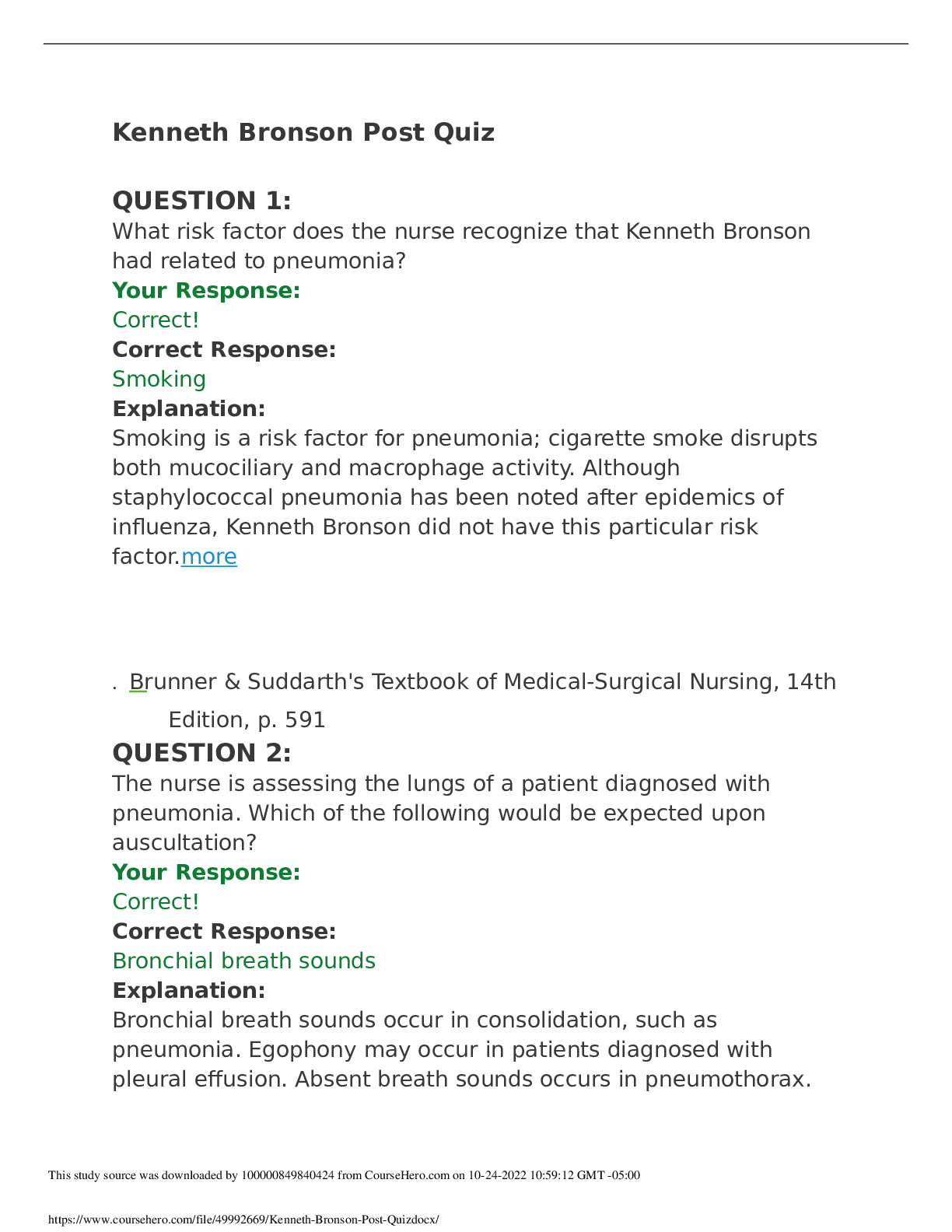



 Questions and Answers 100% VERIFIED.png)
 Questions and Answers 100% correct Solutions.png)



